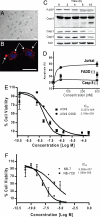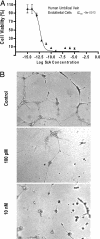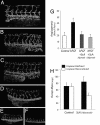The marine lipopeptide somocystinamide A triggers apoptosis via caspase 8
- PMID: 18268346
- PMCID: PMC2268133
- DOI: 10.1073/pnas.0712198105
The marine lipopeptide somocystinamide A triggers apoptosis via caspase 8
Abstract
Screening for novel anticancer drugs in chemical libraries isolated from marine organisms, we identified the lipopeptide somocystinamide A (ScA) as a pluripotent inhibitor of angiogenesis and tumor cell proliferation. The antiproliferative activity was largely attributable to induction of programmed cell death. Sensitivity to ScA was significantly increased among cells expressing caspase 8, whereas siRNA knockdown of caspase 8 increased survival after exposure to ScA. ScA rapidly and efficiently partitioned into liposomes while retaining full antiproliferative activity. Consistent with the induction of apoptosis via the lipid compartment, we noted accumulation and aggregation of ceramide in treated cells and subsequent colocalization with caspase 8. Angiogenic endothelial cells were extremely sensitive to ScA. Picomolar concentrations of ScA disrupted proliferation and endothelial tubule formation in vitro. Systemic treatment of zebrafish or local treatment of the chick chorioallantoic membrane with ScA resulted in dose-dependent inhibition of angiogenesis, whereas topical treatment blocked tumor growth among caspase-8-expressing tumors. Together, the results reveal an unexpected mechanism of action for this unique lipopeptide and suggest future development of this and similar agents as antiangiogenesis and anticancer drugs.
Conflict of interest statement
The authors declare no conflict of interest.
Figures




References
-
- Newman DJ, Cragg GM. Natural products as sources of new drugs over the last 25 years. J Nat Prod. 2007;70:461–477. - PubMed
-
- Venter JC, et al. Environmental genome shotgun sequencing of the Sargasso Sea. Science. 2004;304:66–74. - PubMed
-
- Fenical W, Sethna K, Lloyd GK. Marine microorganisms as a developing resource for drug discovery. Pharmaceutical News. 2002:489–494.
Publication types
MeSH terms
Substances
Grants and funding
LinkOut - more resources
Full Text Sources
Other Literature Sources
Molecular Biology Databases

